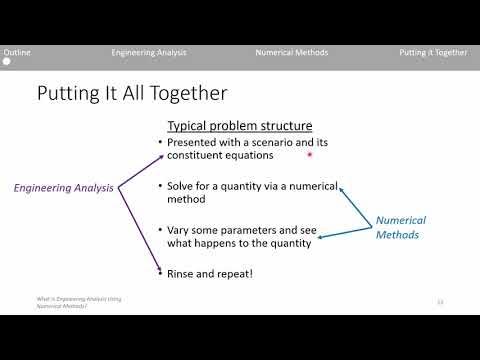METODE NUMERIK P1 | PENDAHULUAN
Summary
TLDRThis lecture introduces numerical methods, focusing on their importance in solving real-world problems modeled mathematically. It explains that when analytical methods fail or become inefficient, numerical methods are used for approximations. The lecture covers key concepts, including the differences between numerical and analytical methods, types of errors (inherent, rounding, and truncation), and accuracy (absolute and relative errors). Iterative approximations are also explored. The lecturer emphasizes that numerical methods are applicable not only for complex problems but also for simpler problems, offering a practical alternative when analytical solutions are too difficult or time-consuming.
Takeaways
- 😀 Numerical methods involve techniques to solve mathematical problems using basic arithmetic operations like addition, subtraction, multiplication, and division.
- 😀 Analytical methods provide exact solutions using algebraic formulas, while numerical methods give approximate solutions.
- 😀 The key difference between numerical and analytical methods is that numerical methods provide solutions in numeric form, while analytical methods yield mathematical functions.
- 😀 Numerical methods can be used to solve both simple and complex mathematical problems, even those that may be inefficient or time-consuming to solve analytically.
- 😀 Numerical solutions are often approximations, and errors can arise during calculations, which are known as errors or 'kesalahan'.
- 😀 There are three main types of errors in numerical methods: inherent errors, rounding errors, and truncation errors.
- 😀 Inherent errors occur due to mistakes in data collection or misreading scales during measurements.
- 😀 Rounding errors happen when numbers are rounded to a specific number of decimal places or significant figures.
- 😀 Truncation errors arise when infinite processes, like series expansions, are truncated or approximated using only a finite number of terms.
- 😀 Errors can be measured using absolute error (the difference between exact and approximated values) and relative error (the ratio of the absolute error to the exact value).
- 😀 In iterative numerical methods, the error is the difference between successive approximations and is referred to as relative iterative error.
Q & A
What is the main focus of this numerical methods course?
-The course focuses on introducing numerical methods, covering their definition, approach, and errors. It explores how mathematical problems in real-life are modeled and solved using numerical techniques.
How are real-life problems related to mathematical models?
-Real-life problems are modeled using mathematical models, often represented by equations. These models can be linear, nonlinear, or other forms of equations. However, these models may be complex and cannot always be solved using analytical methods.
What is an analytical method?
-An analytical method is a technique that solves mathematical models using well-established algebraic formulas. These methods provide exact solutions to problems.
When is a numerical method used instead of an analytical method?
-A numerical method is used when an analytical method cannot be applied, either because the problem is too complex or the model does not have an exact solution. Numerical methods offer approximate solutions through calculations.
What are the main differences between numerical and analytical methods?
-Numerical methods provide approximate solutions in the form of numbers, whereas analytical methods provide exact mathematical functions. Numerical solutions are called 'approximate solutions,' while analytical methods yield exact solutions.
What are the types of errors associated with numerical methods?
-There are three main types of errors: inherent errors, rounding errors, and truncation errors. Inherent errors arise from incorrect data or measurement mistakes, rounding errors occur when numbers are rounded, and truncation errors result from approximating infinite processes with finite terms.
What is an inherent error?
-Inherent error is caused by mistakes in data collection, such as misreading scales or copying data incorrectly. It also occurs when physical laws are misunderstood during measurement.
How does rounding error occur?
-Rounding error occurs when numbers are approximated by rounding them to fewer decimal places. For example, rounding 3.1415926 to 3.14 creates a rounding error.
What is truncation error in numerical methods?
-Truncation error happens when infinite series or processes are approximated by using only a finite number of terms. This occurs when certain terms in a mathematical series are omitted, such as using only the first few terms of an infinite series.
How can accuracy be measured in numerical methods?
-Accuracy can be measured using absolute error and relative error. Absolute error is the absolute difference between the exact and approximated values, while relative error compares this difference to the exact value, often expressed as a percentage.
Outlines

هذا القسم متوفر فقط للمشتركين. يرجى الترقية للوصول إلى هذه الميزة.
قم بالترقية الآنMindmap

هذا القسم متوفر فقط للمشتركين. يرجى الترقية للوصول إلى هذه الميزة.
قم بالترقية الآنKeywords

هذا القسم متوفر فقط للمشتركين. يرجى الترقية للوصول إلى هذه الميزة.
قم بالترقية الآنHighlights

هذا القسم متوفر فقط للمشتركين. يرجى الترقية للوصول إلى هذه الميزة.
قم بالترقية الآنTranscripts

هذا القسم متوفر فقط للمشتركين. يرجى الترقية للوصول إلى هذه الميزة.
قم بالترقية الآنتصفح المزيد من مقاطع الفيديو ذات الصلة
5.0 / 5 (0 votes)






